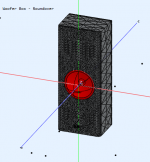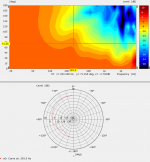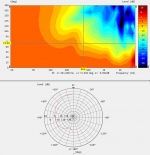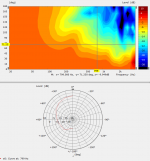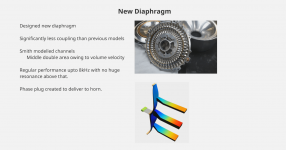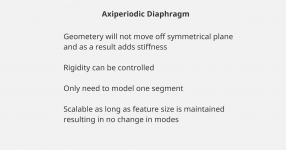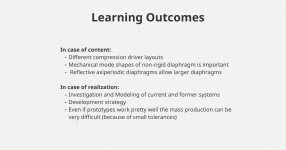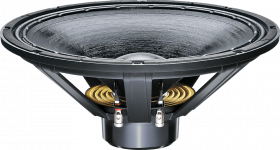Except for the 2nd most popular form of music 🤣 plenty of material below 40hz
I think the same is true for the 4th most popular genre; EDM
Thats assuming you meant hz not db
I think the same is true for the 4th most popular genre; EDM
Thats assuming you meant hz not db
Last edited:
This is a thing. The max spl that the system can reach before leaving xmax...maximum linear dynamic capability.
I am also concerned about sympathetic Distortion ....my word for how the distortion of a low note can pass on to higher notes, the diaphragm is reproducing.
Both ideas lead to a desired amount of headroom, and/or, a desired amount of excursion, at desired spl.
late in my designing I felt that each section (bass, mid, treble) could have similar excursion profiles....1-2mm (or less) at max desired spl...that made the most sense...not always achievable with bass, but....at least try
One could also consider, limiting excursion to 50% xmax at max desired spl
Last edited:
Except for the 2nd most popular form of music 🤣 plenty of material below 40hz
I think the same is true for the 4th most popular genre; EDM
Thats assuming you meant hz not db
An ex-designer rightly noted that most speaker systems capable of -3dB at 40 Hz, are basically 'full range' in most rooms.
Even our slim (2.10 meter high) towers, with port tuning at 45 Hz, have sufficient output down to 30 Hz.
Enough to keep about 30 people dancing to house and techno all night long.
Last edited:
Camplo,
The Hornresp simulation uses a flat circular piston as the model for Diaphragm Displacement. A flat piston's displacement is simply Sd x excursion.
The Axi2050 has a ring radiator diaphragm, the inner and outer annulus is fixed (no excursion) the center can move approximately 1mm, the average displacement being that of a 4" (100mm) diameter piston moving .5mm.
The center point of the Axi2050 diaphragm will hammer the phase plug at approximately 1mm excursion, while the displacement equivalent would be only .5mm.
Your Hornresp simulation indicates that .5mm is reached at about 800 Hz, at 108 dB, with only 2.83v input (1"watt" into an 8 ohm load), but you used 200 rather than 78.82 for S1, oops.
Try again.
Art
Art, I always want to believe that the Axi2050 has 1m of linear travel in either direction....800hz is what I would of guessed for most drivers.
This description from databass seems pretty accurate of the excursion performance. I am not disappointed with the performance of the 18h+ as the lowest woofer, and any mid bass it touches will be handled like any other nice mid bass. As I get comfortable with turning up the volume, I see that larger xmax could be desired by some for the sub 20hz of cinema.
Excursion Behavior
The 18mm gap height and 38mm coil wind height give a geometric coil overhang of 10mm. AE gives an xmax rating of 14mm one way which is probably a good estimate of useful throw since the overhang is 10mm but the 18mm gap is relatively large so BL should drop off gradually. The geometry also indicates that the coil won't completely leave the gap until a one way displacement of 28mm. AE gives an Xmech rating of 25mm one way. From looking at the geometry of the motor we have 51mm of space from the top plate to the back plate and the coil overhang is 10mm leaving what amounts to roughly 40mm of clearance under the coil. There appears to be a similar amount before the triple joint contacts the top plate. Given the coil leaves the gap completely at 28mm and the type of suspension on this woofer it is most assured that this woofer is suspension and/or BL limited long before any physical contact can be made between moving parts. In other words this will be a soft bottom Xmech design. In free air the woofer easily produced excursions of 1.5" peak to peak without undue distress.
This description from databass seems pretty accurate of the excursion performance. I am not disappointed with the performance of the 18h+ as the lowest woofer, and any mid bass it touches will be handled like any other nice mid bass. As I get comfortable with turning up the volume, I see that larger xmax could be desired by some for the sub 20hz of cinema.
Earl gets it (thanks!) but you will believe whatever you want...Art, I always want to believe that the Axi2050 has 1m of linear travel in either direction....800hz is what I would of guessed for most drivers.
The AE woofer is a soft bottom Xmech design.
The Axi2050 has a "hard bottom", it hits Xmech (1mm travel one way when the diaphragm contacts the phase plug), it's displacement being equal to that of a 4" diaphragm traveling 0.5mm one way.
The Axi2050's relatively heavy diaphragm reduces it's HF output sensitivity considerably compared to most 4" diaphragm HF drivers, your OS horn model with rising HF response was a giveaway something was wrong with the model.
There are no decent 4" diaphragm drivers that will reach 0.5mm one way at 800 Hz with only 108 dB output if mounted on a usable horn.
A 1.75" diaphragm driver on a 90 degree OS horn could easily exceed that level without reaching excursion limits.
Art
Last edited:
lol what?> I take it you misread what I wrote...thats ok.but you will believe whatever you want...
I wonder what allows the Axi more low frequency extension if the displacement is no different than the 4" diaphragm
The Axi2050 has a "hard bottom", it hits Xmech
I cannot say because I never reached it on my axi with or without the horn....have you? Without the horn, things got too loud, before I could reach xmech, full sine sweeps with no xO.
This was taken with the mic right at the exit. If I use the pink noise slope to figure head room for the tweeter, placing 115db peak at the bass....above 600hz something around 105db is needed? By 20khz 85db is needed.
Last edited:
My mock up is pretty crude its just a 78.82 diaphragm with a 2" exit in front of it.but you used 200 rather than 78.82 for S1, oops.
Diaphragm volume displacement equivalent to a 5-1/4 inch dome
1mm peak linear displacement (sounds like its more like 0.9mm) 7.2cm3 volume displacement.
I don't know how BL curves perform within compression drivers...Seems like I would want to limit performance to 50% of xmax.
How much juice at what frequency should I try to hit Xmech?
Last edited:
I think so because you actually saidlol what?> I take it you misread what I wrote...thats ok.
You may have meant 1mm, 1m peak is quite some xmax 🙂Art, I always want to believe that the Axi2050 has 1m of linear travel in either direction....
Why would you want to hit xmech in testing or otherwise? The axi is more capable of going lower in frequency than most compression drivers. When you have the waveguide you want run the same measurement as the raw one and see what level of distortion you get.
If you are aiming for the most constant directivity from a waveguide/ woofer combination the best crossover point will be easy enough (higher than it's minimum usable frequency) for the axi to handle.
No worries, I know what you meant and in principle I agree. There is a trend in pro drivers to get the most linear and widest BL curve possible and these tend to come with motors that have super low Qts and create a rising natural response. They are designed to be EQ'd flat with significant power. By your previous 6dB limit they would be compromised. I doubt the manufacturers would agree.Ok, agreed...language a bit too strong....my bad lol 😉
Every speaker is a set of compromises and it's then up to the designer to get the best result out of the design constraints.How about i say compromised design, and by compromised i mean with one particular objective in mind, the objective of maximum linear dynamic capability.
Certainly not a major objective for everyone. It's one of mine, because it seems to clean up sound, even at lower listening levels.
Why would you want to hit xmech in testing or otherwise? The axi is more capable of going lower in frequency than most compression drivers
lol I dunno.....knowledge gained? It is really interesting, how the Axi could possibly go lower than a 4" domed compression driver with identical displacement and exit size...
anyone know?
You might find out how much it costs to replace the diaphragm.lol I dunno.....knowledge gained? It is really interesting, how the Axi could possibly go lower than a 4" domed compression driver with identical displacement and exit size...
anyone know?
The axi has a very different operation to most compression drivers you can see in the exploded photos and videos. The displacement and Sd they are quoting is the equivalent value that it would be for a normal dome.
There is a very good reason for choosing the 12dB/octave rolloff at least as a DSP preset for a production/mastering monitor. That way you know what it actually sounds like down there on something that can produce it.Except for the 2nd most popular form of music 🤣 plenty of material below 40hz
I think the same is true for the 4th most popular genre; EDM
To go back to the point about the woofer polar and the cabinet it is in. Here are some graphs that show why I think it is a good idea to go with something like Earl and bmc0 did.
With a 15" woofer here is the 180 degree directivity polar screenshot at different frequencies to show the line chart view of directivity. I think this a good way of showing that the woofer and box by themselves produce a pretty decent supercardioid response from 1k to 400Hz and there is still 10dB of rear rejection down at 300Hz, which doesn't go back to zero until close to 150Hz.
Attachments
For the same reason you would think that the bandwidth would be also the same (normal)The axi has a very different operation to most compression drivers you can see in the exploded photos and videos. The displacement and Sd they are quoting is the equivalent value that it would be for a normal dome.
You might find out how much it costs to replace the diaphragm.
Baptism by fire... Maybe I could get a free diaphragm at the expense of them not properly sharing full Thiele specs.
There is a very good reason for choosing the 12dB/octave rolloff at least as a DSP preset for a production/mastering monitor. That way you know what it actually sounds like down there on something that can produce it.
I had that thought after @Ro808 commented about systems with 40hz f3. In this project a mastering monitor has been in mind, so the capability of producing linear frequency down to 30hz@115db/1m, is a one way of approaching that.
Last edited:
My thoughts as well....FIR is an option and crossover that I also need to work on designing....My DSP cannot do 12db/oct FIR filters =(.....so either have to settle for the slopes it can create or invest in a sound card with multiple outputs, like we talked about before, and run the filters on Equalizer APO. It might be possible to use the DSP FIR XO's and then use FIR correction on the upstream stereo bus, to clean it up, via software. Still, those 24db slopes for between the 15m and 18h+...I don't like it, bet it messes with how I have the hp on the 15m limiting excursion.....I'll need more from the 18h+ and run into slot issues......maybe.There is a very good reason for choosing the 12dB/octave rolloff at least as a DSP preset for a production/mastering monitor. That way you know what it actually sounds like down there on something that can produce it.
It goes without saying that 'linear' is not the same as 'flat' 😉I had that thought after @Ro808 commented about systems with 40hz f3. In this project a mastering monitor has been in mind, so the capability of producing linear frequency down to 30hz@115db/1m, is a one way of approaching that.
Hey camplo, just as an example and some food for thought.....
I showed earlier in #9544, the tuning i have with my PPSL's made outdoors, which has f-3 @30Hz (really more like 28Hz) .
For grins and illustration, i've made an indoor tuning to go lower.
Here's the mic setup, simply placed between driver slot and ports, about 1/2 m away. Followed by the raw response.
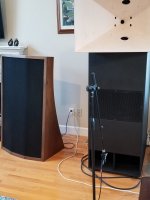
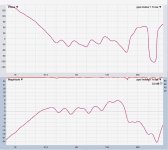
There was surely more ripple than outdoors, but quite a bit less than i expected with that mic placement.
Anyway, popped the raw response into FirD, and said take her response on down to 20Hz or so...
here's the processed response, followed by Group delay.
SPL is 1/48th, Group delay is Psy, as i'm sure you've learned how unreadable any GD trace is without smoothing
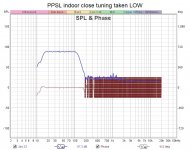
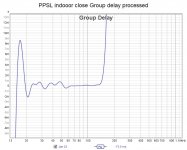
here's the processing magnitude curve to let you see the boost applied to go low.
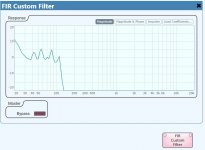
Boost not all that bad really....well, i shouldn't say that until checking excursion in Hornresp, should i?
The ripple adjustments are hokey, and shouldn't be that extreme, but i let them in to show the simple power and ease of FIR.
(Outdoor 4m ripple adjustment are much smaller and fine ime...)
Ok, the food for thought....
This PPSL is bass-reflex. Is that a group delay curve you could live with?
PPSL is only about cabinet vibration reduction ime/imo. The distortion reduction often touted was probably for drivers with more production variances than todays drivers. (And who knows how much the THD even matters.)
If you can't get the low end extension and SPL you want without a great deal of boost, maybe sealed isn't the way to go.....
I know you put a great deal of (nice) work into your subs.....don't mean to say they aren't right for task...i just found out after build sealed and bass-reflex with same driver, bass reflex gave me the low end extension and power i wanted, better than sealed (and with equivalent group delay)
Hey, if i had to build 3 sets of subs to get to what i wanted, you can too! LOL
Personally, for you whole project. I'd do what Earl, fluid, et al, have been saying......work out the AXI/horn integration with your 15"s first. See how low you want to use the 15"s, ....to then integrate with the 18"s. Let go of the sub, and group delay concerns etc....until you see what you have up top.
You may find you need more or less or different sub, depending on what your "texas headphones" / "monitors" end up being.
Also, if you do go the FIR route, your choice of xover frequency slopes increases dramatically with complementary linear phase xovers ....makes tying things together so much easier. It also allows less spillover, where drivers don't have to share so much range together...less lobing potential and less intermod distortion, which may be important for the AXI. The single greatest improvement in SQ I've found in over 2 years of working on MEHs, was relieving the compression drivers of lower end duty, raising their xover point. (using compression drivers that have ability to go low, only exceeded by the AXI afaik)
I showed earlier in #9544, the tuning i have with my PPSL's made outdoors, which has f-3 @30Hz (really more like 28Hz) .
For grins and illustration, i've made an indoor tuning to go lower.
Here's the mic setup, simply placed between driver slot and ports, about 1/2 m away. Followed by the raw response.


There was surely more ripple than outdoors, but quite a bit less than i expected with that mic placement.
Anyway, popped the raw response into FirD, and said take her response on down to 20Hz or so...
here's the processed response, followed by Group delay.
SPL is 1/48th, Group delay is Psy, as i'm sure you've learned how unreadable any GD trace is without smoothing


here's the processing magnitude curve to let you see the boost applied to go low.

Boost not all that bad really....well, i shouldn't say that until checking excursion in Hornresp, should i?
The ripple adjustments are hokey, and shouldn't be that extreme, but i let them in to show the simple power and ease of FIR.
(Outdoor 4m ripple adjustment are much smaller and fine ime...)
Ok, the food for thought....
This PPSL is bass-reflex. Is that a group delay curve you could live with?
PPSL is only about cabinet vibration reduction ime/imo. The distortion reduction often touted was probably for drivers with more production variances than todays drivers. (And who knows how much the THD even matters.)
If you can't get the low end extension and SPL you want without a great deal of boost, maybe sealed isn't the way to go.....
I know you put a great deal of (nice) work into your subs.....don't mean to say they aren't right for task...i just found out after build sealed and bass-reflex with same driver, bass reflex gave me the low end extension and power i wanted, better than sealed (and with equivalent group delay)
Hey, if i had to build 3 sets of subs to get to what i wanted, you can too! LOL
Personally, for you whole project. I'd do what Earl, fluid, et al, have been saying......work out the AXI/horn integration with your 15"s first. See how low you want to use the 15"s, ....to then integrate with the 18"s. Let go of the sub, and group delay concerns etc....until you see what you have up top.
You may find you need more or less or different sub, depending on what your "texas headphones" / "monitors" end up being.
Also, if you do go the FIR route, your choice of xover frequency slopes increases dramatically with complementary linear phase xovers ....makes tying things together so much easier. It also allows less spillover, where drivers don't have to share so much range together...less lobing potential and less intermod distortion, which may be important for the AXI. The single greatest improvement in SQ I've found in over 2 years of working on MEHs, was relieving the compression drivers of lower end duty, raising their xover point. (using compression drivers that have ability to go low, only exceeded by the AXI afaik)
Last edited:
The Axi (with a suitable horn) should work just fine from 400-500 Hz.
A couple of 15 woofers (not a typical midwoofer) can easily cover the first 4-5 octaves, without IMD etc. becoming an issue.
Voilà, the recipe for a high output 2-way monitor.
A couple of 15 woofers (not a typical midwoofer) can easily cover the first 4-5 octaves, without IMD etc. becoming an issue.
Voilà, the recipe for a high output 2-way monitor.
Attachments
Last edited:
How about that 'Big Red Horn' that was created for the Axi almost 3 years ago?The Axi (with a suitable horn) should work just fine from 400-500 Hz.
A couple of 15 woofers (not a typical midwoofer) can easily cover the first 4-5 octaves, without IMD etc. becoming an issue.
Voilà, the recipe for a high output 2-way monitor.
https://audioxpress.com/news/celest...050-axiperiodic-driver-at-prolight-sound-2019
A couple of AETD15S or 15X for the bottom. One would do just fine.
Voilà. Back to the high output 2-way.
Throw in some SI24's for deep sub below 50Hz. 60Hz if using the 15X. That will get the dance floor shakin' for the EDM crowd.
Last edited:
- Home
- Loudspeakers
- Multi-Way
- Is it possible to cover the whole spectrum, high SPL, low distortion with a 2-way?
